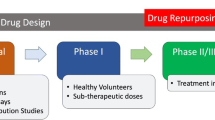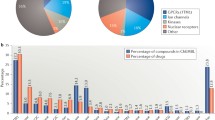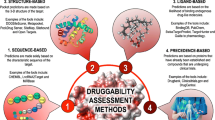ABSTRACT
From research published in the last six years we have identified 34 studies that have screened libraries of FDA-approved drugs against various whole cell or target assays. These studies have each identified one or more compounds with a suggested new bioactivity that had not been described previously. We now show that 13 of these drugs were active against more than one additional disease, thereby suggesting a degree of promiscuity. We also show that following compilation of all the studies, 109 molecules were identified by screening in vitro. These molecules appear to be statistically more hydrophobic with a higher molecular weight and AlogP than orphan-designated products with at least one marketing approval for a common disease indication or one marketing approval for a rare disease from the FDA’s rare disease research database. Capturing these in vitro data on old drugs for new uses will be important for potential reuse and analysis by others to repurpose or reposition these or other existing drugs. We have created databases which can be searched by the public and envisage that these can be updated as more studies are published.


Similar content being viewed by others
REFERENCES
Chong CR, Sullivan Jr DJ. New uses for old drugs. Nature. 2007;448:645–6.
Ashburn TT, Thor KB. Drug repositioning: identifying and developing new uses for existing drugs. Nat Rev Drug Discov. 2004;3:673–83.
Byrne ST, Gu P, Zhou J, Denkin SM, Chong C, Sullivan D, et al. Pyrrolidine dithiocarbamate and diethyldithiocarbamate are active against growing and nongrowing persister Mycobacterium tuberculosis. Antimicrob Agents Chemother. 2007;51:4495–7.
Gloeckner C, Garner AL, Mersha F, Oksov Y, Tricoche N, Eubanks LM, et al. Repositioning of an existing drug for the neglected tropical disease Onchocerciasis. Proc Natl Acad Sci USA. 2010;107:3424–9.
Shim JS, Matsui Y, Bhat S, Nacev BA, Xu J, Bhang HE, et al. Effect of nitroxoline on angiogenesis and growth of human bladder cancer. J Natl Cancer Inst. 2010;102(24):1855–73
Lougheed KE, Taylor DL, Osborne SA, Bryans JS, Buxton RS. New anti-tuberculosis agents amongst known drugs. Tuberculosis (Edinburgh, Scotland). 2009;89:364–70.
Cho W, Brenner M, Peters N, Messing A. Drug screening to identify suppressors of GFAP expression. Hum Mol Genet. 2010;19:3169–78.
Stavrovskaya IG, Narayanan MV, Zhang W, Krasnikov BF, Heemskerk J, Young SS, et al. Clinically approved heterocyclics act on a mitochondrial target and reduce stroke-induced pathology. J Exp Med. 2004;200:211–22.
Weisman JL, Liou AP, Shelat AA, Cohen FE, Guy RK, DeRisi JL. Searching for new antimalarial therapeutics amongst known drugs. Chem Biol Drug Des. 2006;67:409–16.
Gheeya JS, Chen QR, Benjamin CD, Cheuk AT, Tsang P, Chung JY, et al. Screening a panel of drugs with diverse mechanisms of action yields potential therapeutic agents against neuroblastoma. Cancer Biol Ther. 2009;8:2386–95.
Miller SC, Huang R, Sakamuru S, Shukla SJ, Attene-Ramos MS, Shinn P, et al. Identification of known drugs that act as inhibitors of NF-kappaB signaling and their mechanism of action. Biochem Pharmacol. 2010;79:1272–80.
Antczak C, Kloepping C, Radu C, Genski T, Muller-Kuhrt L, Siems K, et al. Revisiting old drugs as novel agents for retinoblastoma: in vitro and in vivo antitumor activity of cardenolides. Invest Ophthalmol Vis Sci. 2009;50:3065–73.
Zhang H, Qian DZ, Tan YS, Lee K, Gao P, Ren YR, et al. Digoxin and other cardiac glycosides inhibit HIF-1alpha synthesis and block tumor growth. Proc Natl Acad Sci USA. 2008;105:19579–86.
Gerber AN, Masuno K, Diamond MI. Discovery of selective glucocorticoid receptor modulators by multiplexed reporter screening. Proc Natl Acad Sci USA. 2009;106:4929–34.
Garrett SC, Hodgson L, Rybin A, Toutchkine A, Hahn KM, Lawrence DS, et al. A biosensor of S100A4 metastasis factor activation: inhibitor screening and cellular activation dynamics. Biochemistry. 2008;47:986–96.
Downey AS, Chong CR, Graczyk TK, Sullivan DJ. Efficacy of pyrvinium pamoate against Cryptosporidium parvum infection in vitro and in a neonatal mouse model. Antimicrob Agents Chemother. 2008;52:3106–12.
Mackey ZB, Baca AM, Mallari JP, Apsel B, Shelat A, Hansell EJ, et al. Discovery of trypanocidal compounds by whole cell HTS of Trypanosoma brucei. Chem Biol Drug Des. 2006;67:355–63.
Zhang L, Yu J, Pan H, Hu P, Hao Y, Cai W, et al. Small molecule regulators of autophagy identified by an image-based high-throughput screen. Proc Natl Acad Sci USA. 2007;104:19023–8.
Rosen J, Gottfries J, Muresan S, Backlund A, Oprea TI. Novel chemical space exploration via natural products. J Med Chem. 2009;52:1953–62.
Vieth M, Siegel MG, Higgs RE, Watson IA, Robertson DH, Savin KA, et al. Characteristic physical properties and structural fragments of marketed oral drugs. J Med Chem. 2004;47:224–32.
Azzaoui K, Hamon J, Faller B, Whitebread S, Jacoby E, Bender A, et al. Modeling promiscuity based on in vitro safety pharmacology profiling data. ChemMedChem. 2007;2:874–80.
Hu Y, Bajorath J. Polypharmacology directed compound data mining: identification of promiscuous chemotypes with different activity profiles and comparison to approved drugs. J Chem Inf Model. 2010;50:2112–8.
Chong CR, Chen X, Shi L, Liu JO, Sullivan Jr DJ. A clinical drug library screen identifies astemizole as an antimalarial agent. Nat Chem Biol. 2006;2:415–6.
Oprea TI. Current trends in lead discovery: are we looking for the appropriate properties? J Comput Aided Mol Des. 2002;16:325–34.
Oprea TI, Davis AM, Teague SJ, Leeson PD. Is there a difference between leads and drugs? A historical perspective. J Chem Inf Comput Sci. 2001;41:1308–15.
Hohman M, Gregory K, Chibale K, Smith PJ, Ekins S, Bunin B. Novel web-based tools combining chemistry informatics, biology and social networks for drug discovery. Drug Discov Today. 2009;14:261–70.
Ekins S, Bradford J, Dole K, Spektor A, Gregory K, Blondeau D, et al. A collaborative database and computational models for tuberculosis drug discovery. Mol BioSyst. 2010;6:840–51.
Ekins S, Kaneko T, Lipinksi CA, Bradford J, Dole K, Spektor A, et al. Analysis and hit filtering of a very large library of compounds screened against Mycobacterium tuberculosis. Mol BioSyst. 2010;6:2316–24.
Ekins S, Hohman M, Bunin BA. Pioneering use of the cloud for development of the collaborative drug discovery (cdd) database. In: Ekins S, Hupcey MAZ, Williams AJ, editors. Collaborative computational technologies for biomedical research, vol. Hoboken: Wiley; 2010. in press.
Ekins S, Williams AJ. Meta-analysis of molecular property patterns and filtering of public datasets of antimalarial “hits” and drugs. MedChemComm. 2010;1:325–30.
Ekins S, Williams AJ. When pharmaceutical companies publish large datasets: an abundance of riches or fool’s gold? Drug Discov Today. 2010;15:812–5.
Kortagere S, Krasowski MD, Ekins S. The importance of discerning shape in molecular pharmacology. Trends Pharmacol Sci. 2009;30:138–47.
Zheng X, Ekins S, Rauffman J-P, Polli JE. Computational models for drug inhibition of the human apical sodium-dependent bile acid transporter. Mol Pharm. 2009;6:1591–603.
Diao L, Ekins S, Polli JE. Novel inhibitors of human organic cation/carnitine transporter (hOCTN2) via computational modeling and in vitro testing. Pharm Res. 2009;26:1890–900.
Keiser MJ, Setola V, Irwin JJ, Laggner C, Abbas AI, Hufeisen SJ, et al. Predicting new molecular targets for known drugs. Nature. 2009;462:175–81.
Ekins S, Williams AJ, Krasowski MD, Freundlich JS. In silico repositioning of approved drugs for rare and neglected diseases. Drug Discov Today 2011;16(7–8):298–310.
DuBois SG, Krailo MD, Lessnick SL, Smith R, Chen Z, Marina N, et al. Phase II study of intermediate-dose cytarabine in patients with relapsed or refractory Ewing sarcoma: a report from the Children’s Oncology Group. Pediatr Blood Cancer. 2009;52:324–7.
O’Connor KA, Roth BL. Finding new tricks for old drugs: an efficient route for public-sector drug discovery. Nat Rev Drug Discov. 2005;4:1005–14.
Feng BY, Simeonov A, Jadhav A, Babaoglu K, Inglese J, Shoichet BK, et al. A high-throughput screen for aggregation-based inhibition in a large compound library. J Med Chem. 2007;50:2385–90.
Huang R, Southall N, Wang Y, Yasgar A, Shinn P, Jadhav A, et al. The NCGC pharmaceutical collection: a comprehensive resource of clinically approved drugs enabling repurposing and chemical genomics. Sci Transl Med. 2011;3(80):80ps16.
Williams AJ. Reviewing data quality in the NCGC pharmaceutical collection browser. http://www.chemconnector.com/2011/04/28/reviewing-data-quality-in-the-ncgc-pharmaceutical-collection-browser/.
ACKNOWLEDGMENTS and DISCLOSURES
SE gratefully acknowledges David Sullivan (Johns Hopkins University) for discussing and suggesting references for JHCCL. Accelrys are kindly thanked for providing Discovery Studio.
SE consults for Collaborative Drug Discovery, Inc. on a Bill and Melinda Gates Foundation: Grant#49852 “Collaborative drug discovery for TB through a novel database of SAR data optimized to promote data archiving and sharing.”
Author information
Authors and Affiliations
Corresponding author
Electronic supplementary material
Below is the link to the electronic supplementary material.
Supplemental Table I
Drugs identified with new uses using HTS methods. This table greatly extends a previously published version (1). CCR5, Chemokine receptor 5; DHFR, Dihydrofolate reductase; DOA, Drugs of abuse, FDA, Food and Drug Administration; GLT1, Glutamate transporter 1; HSP-90, Heat shock protein 90; JHCCL, John Hopkins Clinical Compound Library; Mtb, Mycobacterium tuberculosis; NK-1, neurokinin- 1 receptor; OCTN2 (DOC 197 kb)
Rights and permissions
About this article
Cite this article
Ekins, S., Williams, A.J. Finding Promiscuous Old Drugs for New Uses. Pharm Res 28, 1785–1791 (2011). https://doi.org/10.1007/s11095-011-0486-6
Received:
Accepted:
Published:
Issue Date:
DOI: https://doi.org/10.1007/s11095-011-0486-6




